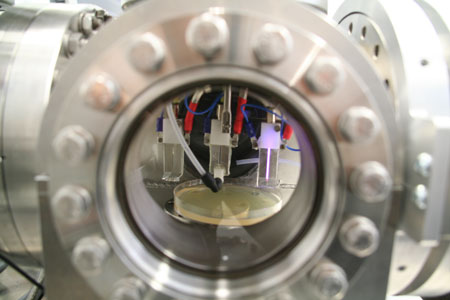| Oct 01, 2013 |
Alternative to antibiotics: plasmas attack bacterial cells on several levels
|
|
(Nanowerk News) As they destroy bacteria very efficiently, plasmas constitute an alternative to chemical disinfectants and potentially to antibiotics, as well. How they achieve this effect has been investigated by biologists, plasma physicists and chemists at the Ruhr-Universität (RUB). Cold atmospheric-pressure plasmas attack the prokaryote’s cell envelope, proteins and DNA.
|
|
“This is too great a challenge for the repair mechanisms and the stress response systems of bacteria,” says Junior Professor Dr Julia Bandow, Head of the Junior Research Group Microbial Antibiotic Research at the RUB. “In order to develop plasmas for specific applications, for example for treating chronic wounds or for root canal disinfection, it is important to understand how they affect cells. Thus, undesirable side effects may be avoided right from the start.”
|
|
The team reports in the Journal of the Royal Society Interface ("Photons and particles emitted from cold atmospheric-pressure plasma inactivate bacteria and biomolecules independently and synergistically").
|
 |
| Plasma reactor: The RUB team generates atmospheric-pressure plasmas and tests which effects UV radiation and reactive particles have on bacterial cells and molecules. (©: RUB)
|
|
Plasmas affect cell envelope, DNA and proteins
|
|
Depending on their specific composition, plasmas may contain different components, for example ions, radicals or light in the ultraviolet spectrum, so-called UV photons. Until now, scientists have not understood which components of the complex mixture contribute to which extent to the antibacterial effect. Julia Bandow’s team has analysed the effect of UV photons and reactive particles, namely radicals and ozone, on both the cellular level and on the level of single biomolecules, namely DNA and proteins. On the cellular level, the reactive particles alone were most effective: they destroyed the cell envelope. On the molecular level, both plasma components were effective. Both UV radiation and reactive particles damaged the DNA; in addition, the reactive particles inactivated proteins.
|
|
No effective antibiotics in ten years’ time?
|
|
Atmospheric-pressure plasmas are already being used as surgical tools, for example in nasal and intestinal polyp extraction. Their properties as disinfectants may also be of interest with regard to medical applications. “In ten years, bacteria might have developed resistance against all antibiotics that are available to us today,” says Julia Bandow. Without antibiotics, surgery would become impossible due to high infection rates.
|

